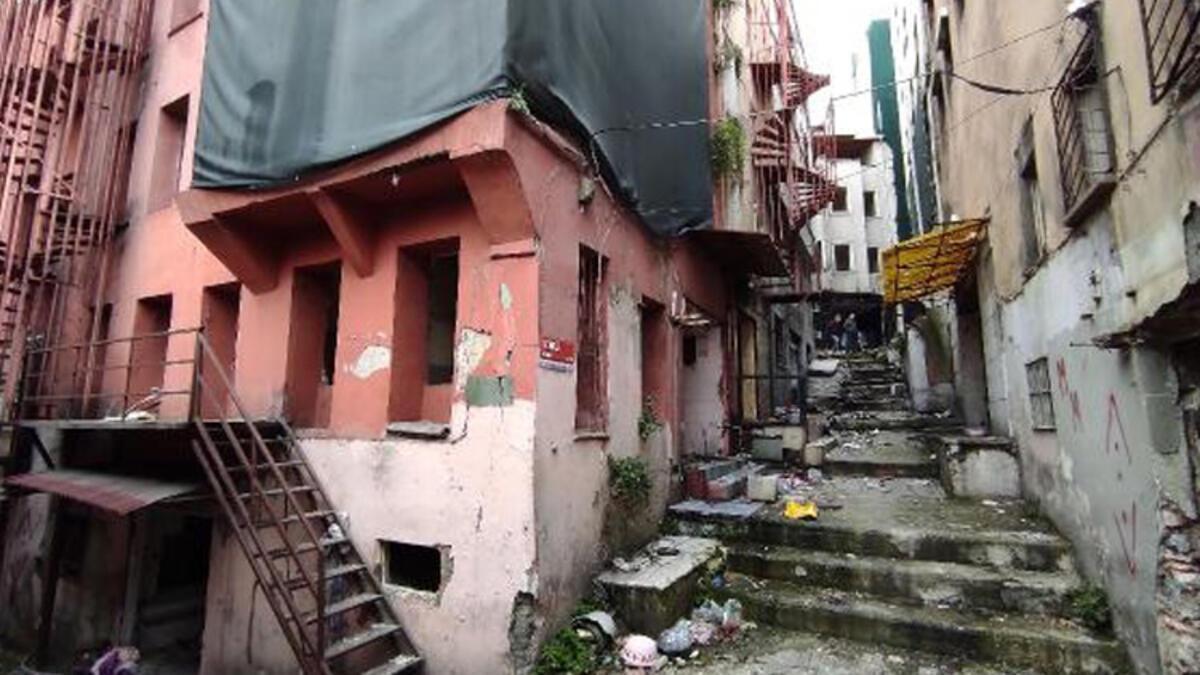The (un) famous streets that once served as Istanbul’s oldest brothels, often neglected in the heart of the city because of their dilapidated appearance, will finally be repaired. And turned into a hot spot, but already the culture and arts.
Most of the properties on Zurafa, Alageik and Kadem streets in the historic Karakoy district, located near the port, have been used as brothels for centuries. But most of them were empty for more than 20 years and only a few worked until the COVID-19 pandemic and health regulations finally put an end to this business.
Accompanied by correspondents and journalists, Beyoglu Mayor Haidar Ali Yildiz visited the site on Monday, saying the area will serve as a center of culture and arts.
The mayor announced that 37 of the 42 properties in the area belong to the heirs of the late brothel owner and tax champion Matild Manukyan. Yildiz thanked the Manukyan family and heirs for their initiative and intention to transform these streets.
“A council of plaintiffs, heirs, NGOs, intellectuals, businessmen will be formed to discuss the transformation,” Yildiz said, adding that the municipality’s role would be to plan the project.
The brothels in Karakoy, once the center of Istanbul’s trade and shipping business, have officially functioned in the area for the past 137 years, initially serving only foreigners under an ordinance issued in 1884 during the reign of Ottoman Sultan Abdulhamid II. But in fact they have been in the area for centuries.
They continued to operate legally during the Republican era, along with other “official” brothels under government monitoring for the security and prevention of sexually transmitted diseases.
Most brothels in the Karakoy area have been closed since the 2000s as local authorities refused to issue new operating permits, along with the government’s overall negative attitude towards official brothels. Four to five brothels are reported to have remained in operation until their services were permanently shut down in March 2020.
The poor condition of the area, which also houses elite schools, prayer churches of various religions and historical landmarks, has long been a source of discontent among locals.
“As the municipality of Beyoğlu, we are bringing a new function to the streets of Zürafa [Giraffe], Alageyik [Fallow deer] and Kadem [Foot],” Haydar Ali Yıldız, the mayor of the district, said in a press conference held in the ruins of the streets on Dec. 20.
The first brothel in Zürafa Street was opened during the era of the Ottoman Sultan Abdülhamit II for “serving the Europeans living in Beyoğlu” in the late 19th century. In the middle of the 20th century, some 120 escorts were working in 18 houses located in Zürafa and the streets nearby.
The brothels were officially closed with the start of the coronavirus pandemic in March 2020.
“Civilizations can be determined with people, time and place. It is our responsibility to shape the future by analyzing the soul of the time,” the mayor said.
“Today I announce that all the houses in the Zürafa Street will convert into art and culture centers. As of today, Zürafa, Alageyik and Kadem will be seen as a cultural zone,” he added.
He especially thanked the three heirs of the Turkish-Armenian businesswoman Matild Manukyan, who own most of the 42 properties in the streets, for helping the municipality.
Born in 1914 and died in 2001, Manukyan, famously known as “brothel boss,” was a tax champion, owning some 37 brothel houses. She also was the owner of some 500 properties, more than 200 taxi plates and dozens of buildings in Istanbul.
During the pandemic, the municipality officials contacted Manukyan’s three heirs, Dora, İlda and Edvin Çilingir, and told the plan.
“Within the scope of the Beyoğlu Culture Road project, these streets will become landmarks of the city in a cultural way,” the mayor highlighted.
According to the project, a board with experts and owners of the properties in the streets will be established. This board will analyze the culture and art zones globally and form an archaeological plan.
The cost of the urban renewal will be taken care of by Manukyan’s heirs and other property owners. According to the officials, the three heirs “accepted to pay for the renewal costs willingly.”
The first thing to do will be to pick garbage and clean the streets.
There is no official renewal plan at the moment, but the mayor underlined that the zone would host cafes, bookshops and cultural activity centers.













 English
English French
French Spanish
Spanish German
German Dutch
Dutch Italian
Italian Danish
Danish Portuguese
Portuguese Greek
Greek Russian
Russian Swedish
Swedish Bulgarian
Bulgarian Hungarian
Hungarian Catalan
Catalan Ukrainian
Ukrainian Polish
Polish Basque
Basque Chinese (Simplified)
Chinese (Simplified) Japanese
Japanese Hebrew
Hebrew Arabic
Arabic Swahili
Swahili Amharic
Amharic Irish
Irish Afrikaans
Afrikaans Albanian
Albanian Armenian
Armenian Azerbaijani
Azerbaijani Belarusian
Belarusian Bengali
Bengali Bosnian
Bosnian Cebuano
Cebuano Chichewa
Chichewa Chinese (Traditional)
Chinese (Traditional) Corsican
Corsican Croatian
Croatian Czech
Czech Esperanto
Esperanto Estonian
Estonian Filipino
Filipino Finnish
Finnish Frisian
Frisian Galician
Galician Georgian
Georgian Gujarati
Gujarati Haitian Creole
Haitian Creole Hausa
Hausa Hawaiian
Hawaiian Hindi
Hindi Hmong
Hmong Icelandic
Icelandic Igbo
Igbo Indonesian
Indonesian Javanese
Javanese Kannada
Kannada Kazakh
Kazakh Khmer
Khmer Korean
Korean Kurdish (Kurmanji)
Kurdish (Kurmanji) Kyrgyz
Kyrgyz Lao
Lao Latin
Latin Latvian
Latvian Lithuanian
Lithuanian Luxembourgish
Luxembourgish Macedonian
Macedonian Malagasy
Malagasy Malay
Malay Malayalam
Malayalam Maltese
Maltese Maori
Maori Marathi
Marathi Mongolian
Mongolian Myanmar (Burmese)
Myanmar (Burmese) Nepali
Nepali Norwegian
Norwegian Pashto
Pashto Persian
Persian Punjabi
Punjabi Romanian
Romanian Samoan
Samoan Scottish Gaelic
Scottish Gaelic Serbian
Serbian Sesotho
Sesotho Shona
Shona Sindhi
Sindhi Sinhala
Sinhala Slovak
Slovak Slovenian
Slovenian Somali
Somali Sundanese
Sundanese Tajik
Tajik Tamil
Tamil Telugu
Telugu Thai
Thai Turkish
Turkish Urdu
Urdu Uzbek
Uzbek Vietnamese
Vietnamese Welsh
Welsh Xhosa
Xhosa Yiddish
Yiddish Yoruba
Yoruba Zulu
Zulu